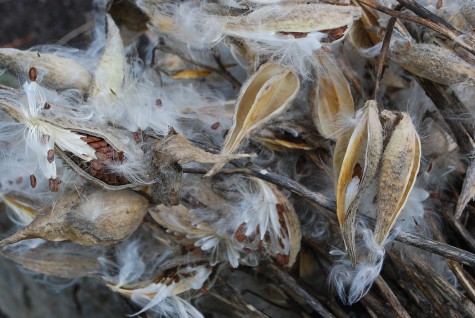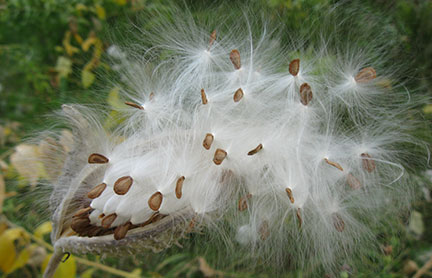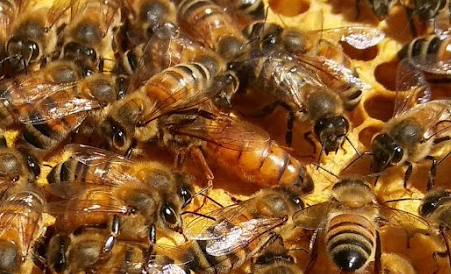This fall, in addition to building boxes, planning next year’s apiary expansion and reading articles on beekeeping, I am collecting seeds. Not just any seeds but beneficial, native and fragrant milkweed seeds. I am sure you have seen them floating around in the brisk fall wind, white puffs that dance through the air as if directed by some unseen choreographer. Next time you see them floating, try not to get too entranced in the dance and get out there to grab some! The process of collecting and planting is not difficult and it could be a great boon not only to your bees but some of our other favorite pollinators such as Monarch Butterflies.
The first step in gathering milkweed seeds is to find them. This process is made easier if you remember where you saw them in the summer, then you can just go to that site and collect to your heart’s content. If you don’t have any areas of known milkweed I suggest driving along some of your local dirt roads, keeping an eye out in the ditches for the yellowing milkweed plant with its teardrop shaped pods jam packed full of fluff and seeds. While you are on that trip looking for milkweed, make sure to keep an eye out for its close cousin, Butterfly Weed. The bright orange flowers of Butterfly Weed are some of my bees favorite and the only reason I don’t have a sack full of Butterfly Weed seeds is I stupidly lost contact with where those plants were earlier this year. Not to worry, I have a lot of Milkweed and Goldenrod to propagate for the benefit of my local pollinators.
So, you found the plants, hopefully they are yellowing on the leaves and their pods should be open or dry and brown enough to open at the slightest squeeze. If the pods are still yellow or green, wait a while for the seeds to mature and collect them at a later date. The next decision you have to make is whether you plan on planting them still this year or whether it would be better to wait until spring. If you plan on immediately planting, go about that in almost the same way you would to get your garden ready in the spring. Rake, till or just generally disturb an area of dirt that gets a good deal of sunshine, water it thoroughly and start placing the seeds with your finger, seed down, fluff up. Cover and wait!

If you can’t plant the seeds now, remove the fluff from the seed and set the seeds aside to store through the winter. When Spring is nigh, you have to get those seeds cold. The best method for that is to layer the seeds in moist paper towel and pop it in the bottom 1/3 of your refrigerator. Give them a 3 week chill before starting them in seed starter pods, of course you can just bring them outside and toss them around to some success, but I recommend starting them in pods and transplanting when warm enough. In general, you need 4 – 6 weeks for the seeds to start in the pods and get strong enough for the transplant, so plan accordingly!
With this process being so easy it is a shame more people don’t partake. The bees need all of the forage they can find and everyone knows the Monarchs need their favorite food on the migration route. So get up, get out there and start collecting!
References :
http://www.monarchwatch.org/milkweed/prop.htm
Michigan State University


